MOSS ANIMALS INVADE LAKE
COCHITUATE
(Article, photos and chart by A.
Richard Miller.)
visits since 970813; last updated 100809.
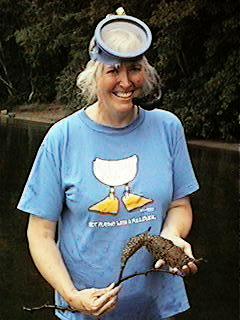 The
lakeshore beside our home is blessed with a sandy beach, and we've been
swimming in its shallows every summer for decades. We watch the fish
watching their fish nests, and we clear the junk that floats down from
the public beach at the far end of Middle Pond. In July 1997, for the first
time, our facemasks gazed upon an unusually large, jelly-like deposit on
a waterlogged stick. We guessed it was some animal's egg mass, perhaps
about to produce many tadpoles or baby fish. Soon we spotted more of the
same, here and there, all lying about the same distance from shore
in about three to four feet of water. Intrigued, we took a piece of a smaller
mass, complete with its encircled twig, up to the house for closer examination.
The
lakeshore beside our home is blessed with a sandy beach, and we've been
swimming in its shallows every summer for decades. We watch the fish
watching their fish nests, and we clear the junk that floats down from
the public beach at the far end of Middle Pond. In July 1997, for the first
time, our facemasks gazed upon an unusually large, jelly-like deposit on
a waterlogged stick. We guessed it was some animal's egg mass, perhaps
about to produce many tadpoles or baby fish. Soon we spotted more of the
same, here and there, all lying about the same distance from shore
in about three to four feet of water. Intrigued, we took a piece of a smaller
mass, complete with its encircled twig, up to the house for closer examination.
Jill Miller (in her "Not Playing with a
Full Duck"
T-shirt) displays a middle-sized example.
We looked, we guessed, we measured, and we used a pocket microscope. We
e-mailed and Web-browsed for information, and we found it. Not fish eggs,
not frog eggs, not insect larvae. They are Bryozoa, literally
moss
animals. Specifically, we have Pectinatella magnifica,
each clump of which can grow to larger than a human head. We can hardly
wait.
Our libary has many books on invertebrate biology, and they all discuss
Bryozoa. Bryozoa are underwater colonies of tiny, colonial animals which,
like sponges, filter water for their food. Unlike sponges, they don't leave
us a handy elastic structure after they die. Worldwide, there are over
3,500 species of bryozoa, but only about 50 of these species inhabit freshwater.
The species we have here, Pectinatella magnifica, is distributed
at least east of the Mississippi River and was identified in Massachusetts
as early as 1866. It has recently been reported as far away as Japan. Although
it is not obvious in most years, this year it has been spotted in other
Massachusetts ponds and lakes, indicating that something is causing it
to grow toward its maximum size.
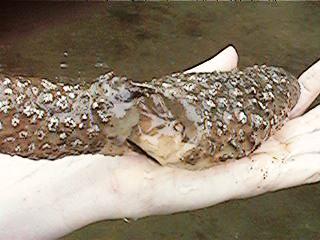 P.
magnifica grows larger than most other species, but has less external form
-- just a coating of firm jelly along a branch or stone, and a semi-visible
set of pea-sized shapes just under a tough outer skin. Its characteristic
lophophores,
the visible portions of the actual animals, poke their tiny stems out into
the water and wave petals to guzzle water and water-borne nutrients. When
disturbed, they all pop back into the jelly in unison.
P.
magnifica grows larger than most other species, but has less external form
-- just a coating of firm jelly along a branch or stone, and a semi-visible
set of pea-sized shapes just under a tough outer skin. Its characteristic
lophophores,
the visible portions of the actual animals, poke their tiny stems out into
the water and wave petals to guzzle water and water-borne nutrients. When
disturbed, they all pop back into the jelly in unison.
Jill holds that same P.magnifica
specimen.
Its supporting twig broke easily, and split
the
mass open to expose its transparent jelly.
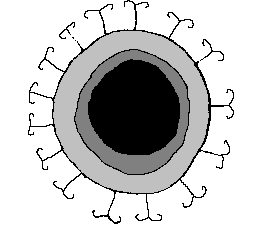 Imbedded
in the jelly are an incredible number of tiny black dots. Under our 30-power
pocket microscope (Radio Shack's tiny and useful illuminated one, at about
$10), each of these blossoms into a delicate circular statoblast.
Picture an egg, sunnyside-up, round but not spherical, with a uniform and
narrow ring of egg-white and, radiating out from that, fifteen delicate
legs each with a pair of slightly hooked, opposing legs at its end. The
"yolk" is black, the "white" tan, and in over half of the samples we observed
there's another inner ring of gold. Neat!
Imbedded
in the jelly are an incredible number of tiny black dots. Under our 30-power
pocket microscope (Radio Shack's tiny and useful illuminated one, at about
$10), each of these blossoms into a delicate circular statoblast.
Picture an egg, sunnyside-up, round but not spherical, with a uniform and
narrow ring of egg-white and, radiating out from that, fifteen delicate
legs each with a pair of slightly hooked, opposing legs at its end. The
"yolk" is black, the "white" tan, and in over half of the samples we observed
there's another inner ring of gold. Neat!
Jill's microscope sketch of a P.mag.
stato-
blast. Its "feet" were only hooked slightly.
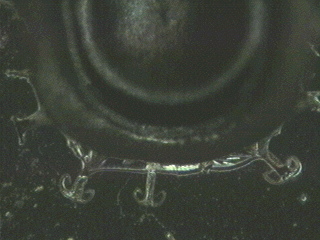
This
statoblast is a
cyst, similar to an egg or spore.
P.mag.
requires warm water; it will die and dissolve -- jelly and all -- as the
lake water cools in the fall. Then the statoblasts are released, their
"whites" inflated like tiny inner tubes, and may show up on shore looking
like windrows of brown powder. Those bristling hooks are ready to hitch
a ride on any passing dog or duck, to show up in another pond. And next
summer, one of these millions of statoblasts can grow a new colony.
created this microphotograph of one of our
P.mag. statoblasts. During the posing
session,
heat and/or drying caused its toes to curl.
Good or Bad?
Should we worry? Or rejoice? These good questions do not yet have clear
answers. One saltwater bryozoan, which can coat North Sea fishermen's nets
when they're hauled aboard, is famous for causing a major skin irritation:
Dogger Bank Itch. (Just saying that makes me scratch.) But our new neighbor,
Pectinatella
magnifica, has no such criminal record. At least one textbook illustration
shows a bare-handed fellow holding a big sample of it, and we're assured
that that's okay. Bryozoa have only recently been getting major scientific
study, and some freshwater varieties are thought to be useful indicators
of water quality. P. magnifica is said to like water which is eutrophic
(that is, it wants to find food in the water) but it doesn't exist in water
which is contaminated. So maybe, just maybe, we should be grateful that
it's thriving here.
Something else was different in our lake in the summer of 1997: the
water was much clearer than usual. We measure this with a Secchi
disk, a 40-cm.-diameter disk painted white on two opposing quadrants,
black on the other two. You drop it on a marked line, until you can't see
it in the murky depths, then bring it back just until you see it again,
and read the line markings. 2 meters of Secchi-disk visibility would normally
be good here in the summertime. (That is, if you dangle your feet down,
you can see your toes but not real well.) 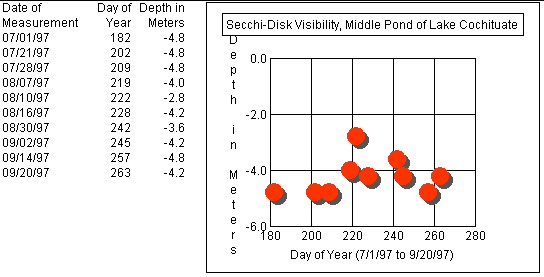 But
in this 1997 summer, we were reading 4.8 meters week after week up to early
August, when it dropped to 4.0 meters on August 7th, then 2.8 meters on
August 10th, back up to 4.2 meters on August 16th, 3.6 meters on August
30th and 4.2 meters on September 2nd.
But
in this 1997 summer, we were reading 4.8 meters week after week up to early
August, when it dropped to 4.0 meters on August 7th, then 2.8 meters on
August 10th, back up to 4.2 meters on August 16th, 3.6 meters on August
30th and 4.2 meters on September 2nd.
Why such outstanding clarity? An unusual drought left us without any
rain from June 15th until a major rain on August 9th. That must have greatly
reduced the amount of water running downstream into the lake, and we postulated
that there was a corresponding lack of the fine silt which takes days to
settle out. Also, there would be less new nutrient introduced, and that
would grow less algae in the water. Hence, we thought, the unusually clear
water.
But if the lake is extra-clear, it should not be sufficiently eutrophic
for this bryozoan. Maybe the bryozoa are making it clear! This bryozoan
is a filter-feeder. Could there be enough of these colonies to filter
a significant amount of particles out of the lake water and into their
gelatinous masses? The bryozoologists think that could be the explanation.
If so, we might want to encourage Pectinatella magnifica to proliferate,
as a natural way to clean up the water despite our region's less environmentally-minded
citizens. We'll remove these underwater colonies from the little section
of shore where we swim. Then, perhaps, we'll tenderly resettle them alongside,
to keep up the good work!
The Pectinatella News
We took the first two photos above on August 21st, 1997. The Pectinatella
magnifica specimen's twig broke then, breaking open the jelly mass.
The specimen still appeared healthy, so we returned it to its spot on the
sandy lakebed.
On Jill's August 30th survey, she again looked at this specimen and
observed no remaining lophophores on the jelly surface; just a thin green
covering, probably an alga. The water had cooled slightly, but was still
pleasant for swimming. Cooling end-of-season water temperature, the crack
in the jelly, or something else? The many other colonies disappeared about
the same time, so we suspect that normal water cooling caused them to dissipate
and release their statoblasts.
Summer 1998 did not have the very-clear water. Although
we still found P. magnifica in the lake, it was not at our beach
and other sites were smaller than in 1997. Perhaps the unusually dry start
to 1997's summer contributed to the increased growth.
Summer 1999: The rainfall again has been unusually low,
and the water clarity has again been high. (6/19, 3.4 m.; 7/3, 3.2m.; 7/29,
4.0m.; 8/17, two days after a rare 1" rain, 4.4m.; 9/2, 4.0m.; 9/5, 4.3m.)
We finally spotted P. magnifica again near our beach, on 7/30; one
egg-sized, egg-shaped blob on the end of a stick poking up from the bottom.
Others, also moderate in size, are reported elsewhere in the lake.
We now think the low summertime rainfalls in 1997 and 1999, combined
with lawn-watering restrictions, kept upstream residents from investing
in chemical fertilizers. Less fertilizer, and less rain run-off to move
it downhill into the lake, would reduce in-lake nutrients and probably
are the main contributors to our improved water clarity.
Summer 2000: (7/8, 4.0 m.; 8/27, 3.0 M., no P. magnifica
yet sighted.)
000830: Albert Oller reports at least 15 P. magnifica in the Charles
River in nearby Needham, Ma.: "They are almost as big as footballs."
Summer 2010: We haven't yet enjoyed another season of large P. magnifica at Lake Cochituate. But we continue to enjoy many reports from other ponds, near and far.
Resources
E-mail from the experts: Byron Backus,
Bill
Banta, Tim Wood.
Links: The
Bryozoa Home Page
Introduction
to the Bryozoa (U.Cal./Berkeley) and Lophophores
(U.Cal./Berkeley)
The
Secchi Disk - What Is It?
Secchi
Depth as a Water Quality Parameter
Lake
Cochituate and Cochituate State Park
Library: Look up Bryozoa in books on Invertebrate Zoology, Pond
Life, etc.
 The
lakeshore beside our home is blessed with a sandy beach, and we've been
swimming in its shallows every summer for decades. We watch the fish
watching their fish nests, and we clear the junk that floats down from
the public beach at the far end of Middle Pond. In July 1997, for the first
time, our facemasks gazed upon an unusually large, jelly-like deposit on
a waterlogged stick. We guessed it was some animal's egg mass, perhaps
about to produce many tadpoles or baby fish. Soon we spotted more of the
same, here and there, all lying about the same distance from shore
in about three to four feet of water. Intrigued, we took a piece of a smaller
mass, complete with its encircled twig, up to the house for closer examination.
The
lakeshore beside our home is blessed with a sandy beach, and we've been
swimming in its shallows every summer for decades. We watch the fish
watching their fish nests, and we clear the junk that floats down from
the public beach at the far end of Middle Pond. In July 1997, for the first
time, our facemasks gazed upon an unusually large, jelly-like deposit on
a waterlogged stick. We guessed it was some animal's egg mass, perhaps
about to produce many tadpoles or baby fish. Soon we spotted more of the
same, here and there, all lying about the same distance from shore
in about three to four feet of water. Intrigued, we took a piece of a smaller
mass, complete with its encircled twig, up to the house for closer examination.
 P.
magnifica grows larger than most other species, but has less external form
-- just a coating of firm jelly along a branch or stone, and a semi-visible
set of pea-sized shapes just under a tough outer skin. Its characteristic
lophophores,
the visible portions of the actual animals, poke their tiny stems out into
the water and wave petals to guzzle water and water-borne nutrients. When
disturbed, they all pop back into the jelly in unison.
P.
magnifica grows larger than most other species, but has less external form
-- just a coating of firm jelly along a branch or stone, and a semi-visible
set of pea-sized shapes just under a tough outer skin. Its characteristic
lophophores,
the visible portions of the actual animals, poke their tiny stems out into
the water and wave petals to guzzle water and water-borne nutrients. When
disturbed, they all pop back into the jelly in unison. Imbedded
in the jelly are an incredible number of tiny black dots. Under our 30-power
pocket microscope (Radio Shack's tiny and useful illuminated one, at about
$10), each of these blossoms into a delicate circular statoblast.
Picture an egg, sunnyside-up, round but not spherical, with a uniform and
narrow ring of egg-white and, radiating out from that, fifteen delicate
legs each with a pair of slightly hooked, opposing legs at its end. The
"yolk" is black, the "white" tan, and in over half of the samples we observed
there's another inner ring of gold. Neat!
Imbedded
in the jelly are an incredible number of tiny black dots. Under our 30-power
pocket microscope (Radio Shack's tiny and useful illuminated one, at about
$10), each of these blossoms into a delicate circular statoblast.
Picture an egg, sunnyside-up, round but not spherical, with a uniform and
narrow ring of egg-white and, radiating out from that, fifteen delicate
legs each with a pair of slightly hooked, opposing legs at its end. The
"yolk" is black, the "white" tan, and in over half of the samples we observed
there's another inner ring of gold. Neat!
 This
statoblast is a cyst, similar to an egg or spore. P.mag.
requires warm water; it will die and dissolve -- jelly and all -- as the
lake water cools in the fall. Then the statoblasts are released, their
"whites" inflated like tiny inner tubes, and may show up on shore looking
like windrows of brown powder. Those bristling hooks are ready to hitch
a ride on any passing dog or duck, to show up in another pond. And next
summer, one of these millions of statoblasts can grow a new colony.
This
statoblast is a cyst, similar to an egg or spore. P.mag.
requires warm water; it will die and dissolve -- jelly and all -- as the
lake water cools in the fall. Then the statoblasts are released, their
"whites" inflated like tiny inner tubes, and may show up on shore looking
like windrows of brown powder. Those bristling hooks are ready to hitch
a ride on any passing dog or duck, to show up in another pond. And next
summer, one of these millions of statoblasts can grow a new colony.
 But
in this 1997 summer, we were reading 4.8 meters week after week up to early
August, when it dropped to 4.0 meters on August 7th, then 2.8 meters on
August 10th, back up to 4.2 meters on August 16th, 3.6 meters on August
30th and 4.2 meters on September 2nd.
But
in this 1997 summer, we were reading 4.8 meters week after week up to early
August, when it dropped to 4.0 meters on August 7th, then 2.8 meters on
August 10th, back up to 4.2 meters on August 16th, 3.6 meters on August
30th and 4.2 meters on September 2nd.